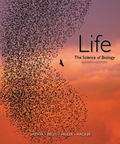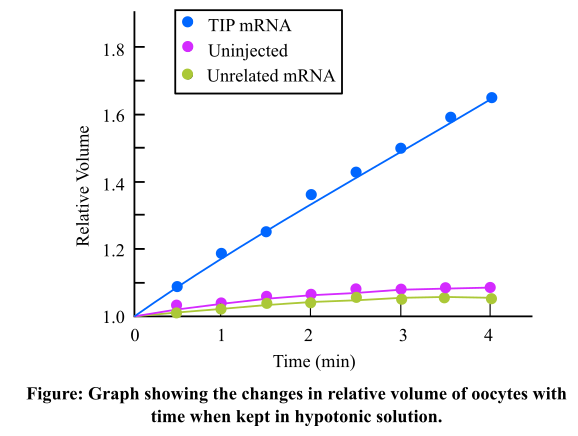
To review:
The role of tonoplast intrinsic protein (TIP) and the importance of the two mentioned conditions by the researchers in the experiment.
Given:
In the first case, researchers injected the oocytes of the frog Xenopus laevis which are large in size with a low osmotic cell permeability with the messenger ribonucleic acid (mRNA) of plant TIP. In the second case, the oocytes were injected with mRNA of a protein which does not help in transport whereas, in the third case, researchers kept the oocytes uninjected. They were observed after incubation of 2 days in isotonic medium and treatment with hypotonic solution.
The following graph was plotted showing the changes in relative volume of the different oocytes of the three cases over time:

It was also observed that the oocytes which were injected by TIP mRNA bursts after sometime while others do not. The following table depicts the osmotic water permeability of the three conditions as calculated by the researchers:

Introduction:
TIP is a transport protein present in the tonoplast of the plant cell. It helps in transport of molecules just like the other aquaporins. Also, hypotonic solution is that solution which has higher water potential than the cell so that due to the difference in water potential, the water moves inside the cell and swells up.
Explanation of Solution
From the graph, it can be concluded that with time, there is a significant increase in the volume of the oocytes that were injected with the mRNA of TIP. On the other hand, there is a very little increase in the relative volumes of the oocytes which were injected with mRNA of nontransport protein and the oocytes that were not injected at all. This happened due to the fact that when the oocytes were kept in the hypotonic solution, entry of water inside the cell took place because of the difference in water potential. The movement was rapid and in large quantity in the first case as compared to the second and the third case. The entry in the first case was rapid as TIP which is a transport protein increased the osmotic permeability of the oocytes, allowed the entry of more water and lead to the increase in volume of the oocytes.
Also, for the interpretation of the experiment the other two conditions were important as they proved that in absence of TIP the transportation occurs in a normal way and there is a little change in the volume of the oocytes.
Hence, it can be concluded that the TIP which is a transport protein is responsible for the increment in the relative volume of the oocyte cells as it increases their permeability and hence leads to their bursting.
Want to see more full solutions like this?
Chapter 34 Solutions
EBK LIFE: THE SCIENCE OF BIOLOGY
- Describe the principle of homeostasis.arrow_forwardExplain how the hormones of the glands listed below travel around the body to target organs and tissues : Pituitary gland Hypothalamus Thyroid Parathyroid Adrenal Pineal Pancreas(islets of langerhans) Gonads (testes and ovaries) Placentaarrow_forwardWhat are the functions of the hormones produced in the glands listed below: Pituitary gland Hypothalamus Thyroid Parathyroid Adrenal Pineal Pancreas(islets of langerhans) Gonads (testes and ovaries) Placentaarrow_forward
- Describe the hormones produced in the glands listed below: Pituitary gland Hypothalamus Thyroid Parathyroid Adrenal Pineal Pancreas(islets of langerhans) Gonads (testes and ovaries) Placentaarrow_forwardPlease help me calculate drug dosage from the following information: Patient weight: 35 pounds, so 15.9 kilograms (got this by dividing 35 pounds by 2.2 kilograms) Drug dose: 0.05mg/kg Drug concentration: 2mg/mLarrow_forwardA 25-year-old woman presents to the emergency department with a 2-day history of fever, chills, severe headache, and confusion. She recently returned from a trip to sub-Saharan Africa, where she did not take malaria prophylaxis. On examination, she is febrile (39.8°C/103.6°F) and hypotensive. Laboratory studies reveal hemoglobin of 8.0 g/dL, platelet count of 50,000/μL, and evidence of hemoglobinuria. A peripheral blood smear shows ring forms and banana-shaped gametocytes. Which of the following Plasmodium species is most likely responsible for her severe symptoms? A. Plasmodium vivax B. Plasmodium ovale C. Plasmodium malariae D. Plasmodium falciparumarrow_forward
- please fill in missing parts , thank youarrow_forwardplease draw in the answers, thank youarrow_forwarda. On this first grid, assume that the DNA and RNA templates are read left to right. DNA DNA mRNA codon tRNA anticodon polypeptide _strand strand C с A T G A U G C A TRP b. Now do this AGAIN assuming that the DNA and RNA templates are read right to left. DNA DNA strand strand C mRNA codon tRNA anticodon polypeptide 0 A T G A U G с A TRParrow_forward
 Principles Of Radiographic Imaging: An Art And A ...Health & NutritionISBN:9781337711067Author:Richard R. Carlton, Arlene M. Adler, Vesna BalacPublisher:Cengage Learning
Principles Of Radiographic Imaging: An Art And A ...Health & NutritionISBN:9781337711067Author:Richard R. Carlton, Arlene M. Adler, Vesna BalacPublisher:Cengage Learning- Case Studies In Health Information ManagementBiologyISBN:9781337676908Author:SCHNERINGPublisher:Cengage





